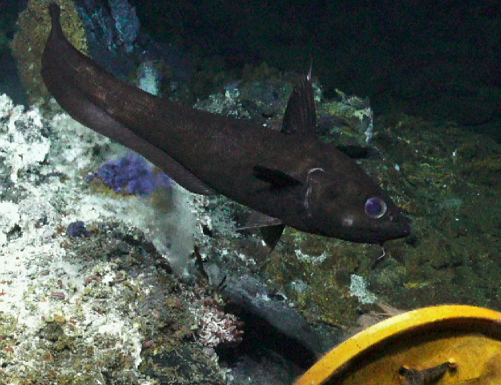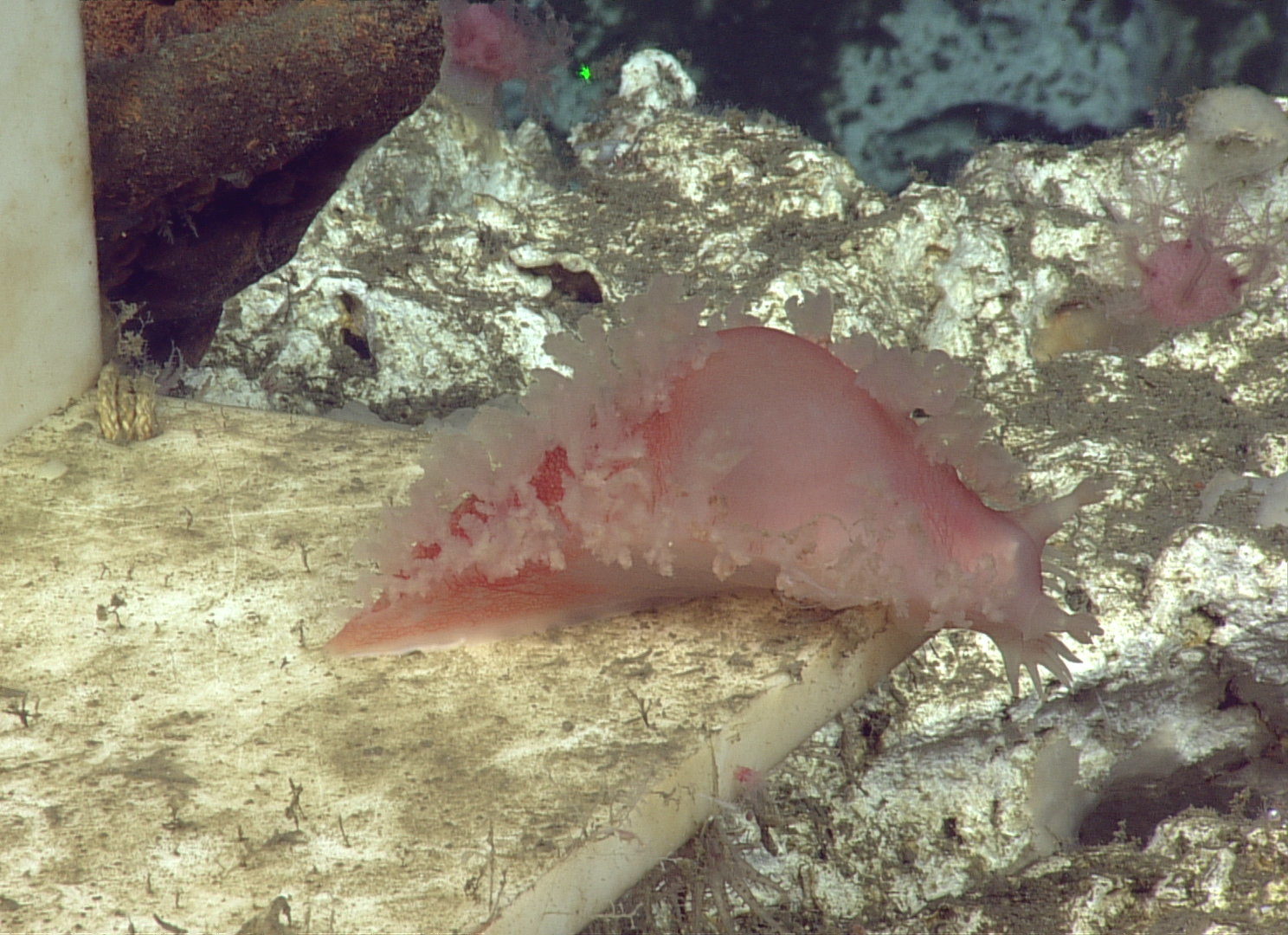Image Archive





























A unique community of invertebrates gathered around the anchor of the Slope Base profiler mooring in 2900 meters (~9500 feet) of water, including a Bathydoris nudibranch, flytrap anemones, galatheid crabs, and sea cucumbers. Photo credit: NSF-OOI/UW/CSSF, Dive R2258, V22

A Tanner crab on the sediment at Southern Hydrate Ridge. Credit: UW/NSF-OOI/CSSF, Dive R2228, V22.

A Graneledone octopus hides among bizarre lava flow structures near International District vent field in Axial Caldera. Credit: UW/NSF-OOI/CSSF, Dive R2213, V22.

A warty, deep-sea purple octopus (Graneledone boreopacifica) sitting on a lava flow at Axial Seamount. Credit: NSF-OOI/UW/CSSF, Dive R2213, V22

A scarlet king crab walking on a carbonate outcrop at Pinnacle, near Southern Hydrate Ridge. Credit: UW/NSF-OOI/CSSF, Dive R2228, V22.

A Brown Catshark checking out ROPOS during a survey at Southern Hydrate Ridge. Credit: UW/NSF-OOI/CSSF, Dive R2224, V22.

A battered, old king crab covered in lesions and tube worms, seen at Pinnacle, near Southern Hydrate Ridge. Credit: UW/NSF-OOI/CSSF, Dive R2228, V22.

A rosy Tritonia nudibranch crawling over the seafloor next to a denuded bubblegum coral at Pinnacle, near Southern Hydrate Ridge. Credit: UW/NSF-OOI/CSSF, Dive R2228, V22.

A Poralia jellyfish drifting past a carbonate outcrop covered in soft corals at Pinnacle, near Southern Hydrate Ridge. Credit: UW/NSF-OOI/CSSF, Dive R2228, V22.

A hagfish swimming over carbonate rock at Pinnacle, near Southern Hydrate Ridge. Credit: UW/NSF-OOI/CSSF, Dive R2228, V22.

A rockfish lying nose to tail with a cod on the carbonate rock at Pinnacle, near Southern Hydrate Ridge. Credit: UW/NSF-OOI/CSSF, Dive R2228, V22.

A bubblegum coral with its feeding polyps either retracted or missing (possibly eaten by a nearby nudibranch), seen at Pinnacle, near Southern Hydrate Ridge. Credit: UW/NSF-OOI/CSSF, Dive R2228, V22.

Close-up of a Dover sole at Southern Hydrate Ridge, lying on bacterial mats and clam beds. Credit: UW/NSF-OOI/CSSF, Dive R2228, V22.

A Dover sole eyeing the submersible as it rests on a bacterial mat at Southern Hydrate Ridge. Credit: UW/NSF-OOI/CSSF, Dive R2228, V22.

A translucent sea cucumber crawling past some brittle stars (ophiuroids) at Southern Hydrate Ridge. Credit: UW/NSF-OOI/CSSF, Dive R2228, V22.

A Brown Catshark swimming near the seafloor at Southern Hydrate Ridge. Credit: UW/NSF-OOI/CSSF, Dive R2228, V22.

A Brown Catshark swimming above orange bacterial mats near Southern Hydrate Ridge. Credit: UW/NSF-OOI/CSSF, Dive R2228, V22.

A hagfish burrowing into the sediment near Southern Hydrate Ridge. Credit: UW/NSF-OOI/CSSF, Dive R2228, V22.

A bubblegum coral (Paragorgia arborea) seen at Pinnacle, west of the main seep sites at Southern Hydrate Ridge. Credit: UW/NSF-OOI/CSSF, Dive R2228, V22.

A Beroe ctenophore (comb jelly) seen at Pinnacle, near Southern Hydrate Ridge. Soft corals attached to authigenic carbonate outcrops can be seen in the background. Credit: UW/NSF-OOI/CSSF, Dive R2228, V22.

Brown anemones are thriving in a diffuse flow site in teh ASHE hydrothermal field. The site also hosts thick microbial mats, filamentous bacteria, tubeworms and limpets. Credti: UW/NSF-OOI/CSSF; V22.

This squished-looking Flapjack octopus (Opisthoteuthis sp.) was seen at Southern Hydrate Ridge during a site survey in 2022. Credit: UW/NSF-OOI/CSSF, ROPOS Dive R2228, V22.

This rosy Tritonia tetraquetra nudibranch was seen sitting on a marker at the Pinnacle, west of Southern Hydrate Ridge. It was near some soft corals, some of which were missing polyps, and had clearly been grazed on by this sea pen and soft coral specialist predator! Photo credit: UW/NSF-OOI/CSSF, Dive R2228, V22.

Bathydoris aioca, an unusually large (~30 cm) deep-sea nudibranch, was part of a unique community of invertebrates gathered around the anchor of the Slope Base profiler mooring in 2900 meters (~9500 feet) of water, also including flytrap anemones, galatheid crabs, and sea cucumbers. Photo credit: NSF-OOI/UW/CSSF, Dive R2258, V22

Unidentified deep-sea nudibranchs found on equipment at approximately 1267 m during a dive at Central Axial Caldera. Photo credit: NSF-OOI/UW/CSSF; Dive J2-1375; V21.

A Fathead Sculpin (Psychrolutes phrictus), also known as a blob sculpin, resting on the seafloor during a dive to the International District. Credit: UW/NSF-OOI/UW/WHOI; Dive J2-1381; V21.

This rattail fish (Coryphaenoides acrolepis), seen amidst the vents in the International District at 1518 m, was incredibly curious about the equipment that Jason was working with. Credit: UW/NSF-OOI/WHOI; Dive J2-1380; V21.

An unidentified, swimming sea cucumber seen at approximately 1274 m on a ROPOS dive to the Central Axial Caldera. Photo credit: NSF-OOI/UW/CSSF; Dive J2-1376; V21.
- Anemone
- Animal
- Arthropod
- ASHES
- Axial
- Axial Base
- Axial Biology
- Axial Caldera
- Bacteria
- Basalt Lava
- BEP
- Biofouling
- biolgoy
- Biology
- Camds
- Camera
- Camhd
- Central Caldera
- Ciliates
- Cnidaria
- Coastal Biology
- Crab
- Deep Profiler Mooring
- Dive Highlights
- Eastern Caldera
- Echinoderms
- Endurance Array
- Engineering Team
- ENLIGHTEN 10
- Exploratorium
- Fish
- Geology
- HD Camera
- HPIES
- Hydrate Ridge
- Hydrates
- Hydrophone
- Hydrothermal Vents
- Illustration
- Inshore 80 Meters
- Instrument
- International District
- J-BOX
- Jason
- Jellyfish
- Junction Box
- K12
- Lava
- Mollusk
- Moorings
- Nodes
- Nudibranch
- Octopus
- OOI
- Oregon Offshore
- Oregon Offshore 600 m
- Oregon Shelf
- Oregon Slope Base
- People
- PN1B
- PN1D
- Polychaetes
- PPSDN
- Primary Node
- RASFL
- ROCLS
- ROPOS
- ROPOS Dives
- ROV Team
- RV Revelle
- RV Sikuliaq
- RV Thompson
- Salp
- Sample
- SC13
- Science Team
- Sea Cucumber
- Sea Star
- Sea Urchin
- Seafloor
- Seismometer
- Sensors
- Shallow Profiler Mooring
- Shark
- Shipboard
- Shore Station
- Slope Base
- Smoker
- Soft Coral
- Southern Hydrate Ridge
- Sponge
- Squid
- Students
- Students & Guest Participants
- Tmpsf
- Tubeworms
- VISIONS 11 Leg 1
- VISIONS 11 Leg 2
- VISIONS 11 Viewers
- VISIONS 13
- VISIONS 14
- VISIONS 15
- VISIONS 16
- VISIONS 17
- VISIONS 18
- VISIONS 20
- VISIONS 22
- VISIONS 23
- Visualization
